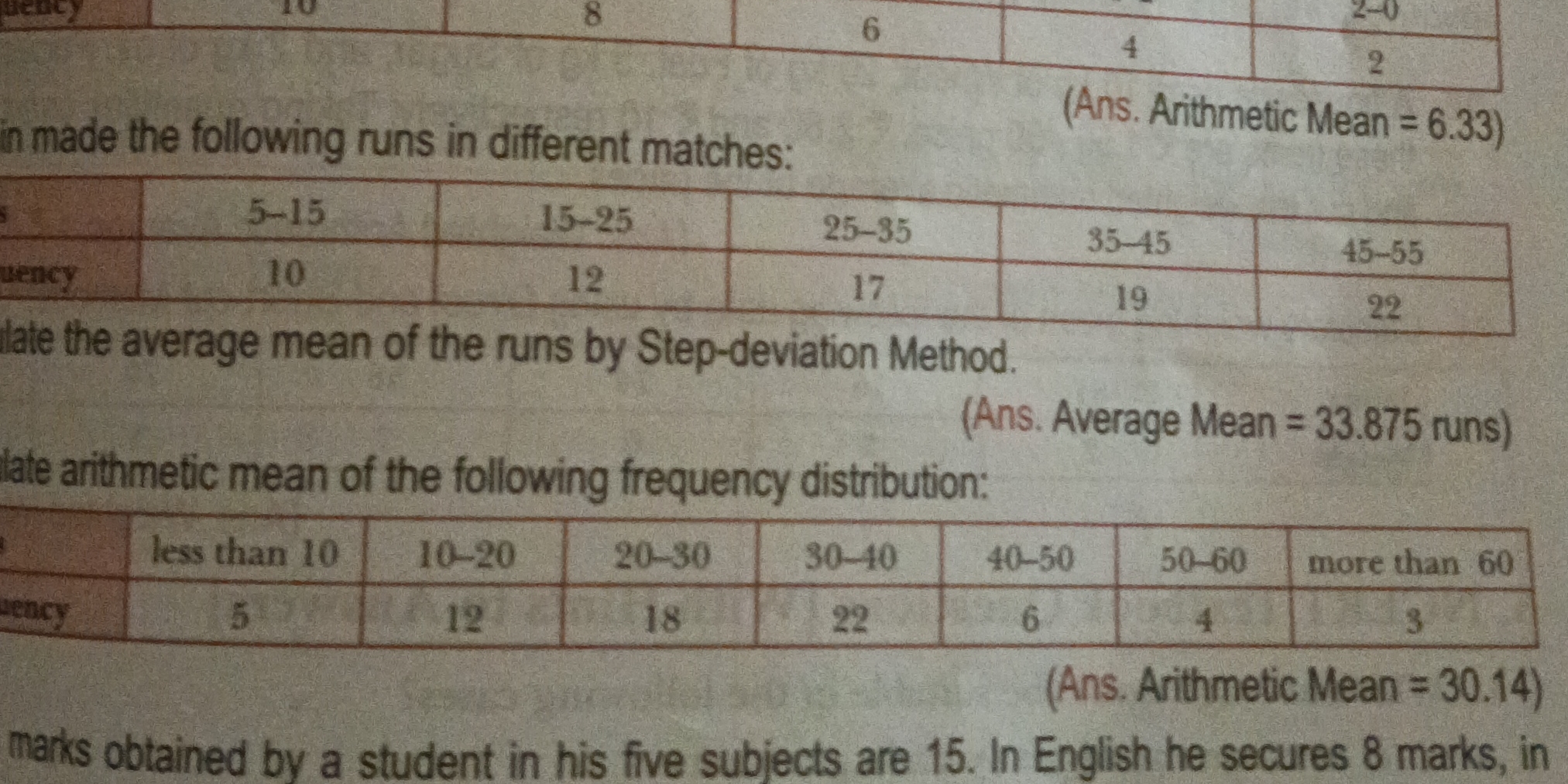Calculate the average mean of the runs by the Step-deviation Method, given the following data: Runs: 5-15, 15-25, 25-35, 35-45, 45-55 Frequency: 10, 12, 17, 19, 22 Calculate arit... Calculate the average mean of the runs by the Step-deviation Method, given the following data: Runs: 5-15, 15-25, 25-35, 35-45, 45-55 Frequency: 10, 12, 17, 19, 22 Calculate arithmetic mean of the following frequency distribution: Values: less than 10, 10-20, 20-30, 30-40, 40-50, 50-60, more than 60 Frequency: 5, 12, 18, 22, 6, 4, 3

Understand the Problem
The image contains math problems, specifically related to statistics and calculating the arithmetic mean. The first problem involves calculating the average mean of runs using the Step-deviation Method. The second problem involves calculating the arithmetic mean of a frequency distribution. The last problem is incomplete.
Answer
Problem 1: $33.875$ Problem 2: $30.14$
Answer for screen readers
Problem 1: The average mean of the runs is $33.875$.
Problem 2: The arithmetic mean of the frequency distribution is $30.14$.
Steps to Solve
Here are the steps to solve the two problems.
Problem 1: Calculating the average mean of runs.
- Find the midpoints $x_i$ of each class interval.
The midpoint is calculated as (lower limit + upper limit) / 2.
- 5-15: $(5 + 15) / 2 = 10$
- 15-25: $(15 + 25) / 2 = 20$
- 25-35: $(25 + 35) / 2 = 30$
- 35-45: $(35 + 45) / 2 = 40$
- 45-55: $(45 + 55) / 2 = 50$
- Choose an assumed mean $a$.
Let's take $a = 30$.
- Calculate the step deviations $u_i = (x_i - a) / h$, where $h$ is the class size.
Here, $h = 10$.
- $u_1 = (10 - 30) / 10 = -2$
- $u_2 = (20 - 30) / 10 = -1$
- $u_3 = (30 - 30) / 10 = 0$
- $u_4 = (40 - 30) / 10 = 1$
- $u_5 = (50 - 30) / 10 = 2$
-
Multiply the frequencies $f_i$ by the step deviations $u_i$.
- $f_1u_1 = 10 \times -2 = -20$
- $f_2u_2 = 12 \times -1 = -12$
- $f_3u_3 = 17 \times 0 = 0$
- $f_4u_4 = 19 \times 1 = 19$
- $f_5u_5 = 22 \times 2 = 44$
-
Calculate $\sum f_i u_i$ .
$\sum f_i u_i = -20 + (-12) + 0 + 19 + 44 = 31$
- Calculate $\sum f_i$ .
$\sum f_i = 10 + 12 + 17 + 19 + 22 = 80$
- Apply the step-deviation formula to find the mean.
$\text{Mean} = a + h \times (\sum f_i u_i / \sum f_i)$ $\text{Mean} = 30 + 10 \times (31 / 80) = 30 + 10 \times 0.3875 = 30 + 3.875 = 33.875$
Problem 2: Calculating the arithmetic mean of the frequency distribution.
- Convert the 'less than' and 'more than' frequencies to class intervals.
The intervals are:
- Less than 10: 0-10, Frequency = 5
- 10-20, Frequency = 12
- 20-30, Frequency = 18
- 30-40, Frequency = 22
- 40-50, Frequency = 6
- 50-60, Frequency = 4
- More than 60: 60-70 (assuming a class size of 10), Frequency = 3
- Find the midpoints $x_i$ of each class interval.
- 0-10: $(0 + 10) / 2 = 5$
- 10-20: $(10 + 20) / 2 = 15$
- 20-30: $(20 + 30) / 2 = 25$
- 30-40: $(30 + 40) / 2 = 35$
- 40-50: $(40 + 50) / 2 = 45$
- 50-60: $(50 + 60) / 2 = 55$
- 60-70: $(60 + 70) / 2 = 65$
-
Multiply the frequencies $f_i$ by the midpoints $x_i$.
- $5 \times 5 = 25$
- $12 \times 15 = 180$
- $18 \times 25 = 450$
- $22 \times 35 = 770$
- $6 \times 45 = 270$
- $4 \times 55 = 220$
- $3 \times 65 = 195$
-
Calculate $\sum f_i x_i$.
$\sum f_i x_i = 25 + 180 + 450 + 770 + 270 + 220 + 195 = 2110$
- Calculate $\sum f_i$ .
$\sum f_i = 5 + 12 + 18 + 22 + 6 + 4 + 3 = 70$
- Compute the arithmetic mean.
$\text{Mean} = \sum f_i x_i / \sum f_i$ $\text{Mean} = 2110 / 70 = 30.1428 \approx 30.14$
Problem 1: The average mean of the runs is $33.875$.
Problem 2: The arithmetic mean of the frequency distribution is $30.14$.
More Information
The step-deviation method simplifies the calculation of the mean by reducing the size of the numbers involved, especially when dealing with large data sets and class intervals of equal size.
Tips
Problem 1: A common mistake is to not use the step-deviation method correctly or making errors in the calculations of $u_i$. Problem 2: Sometimes students calculate the midpoint incorrectly or fail to convert the "less than" and "more than" categories into defined intervals.
AI-generated content may contain errors. Please verify critical information